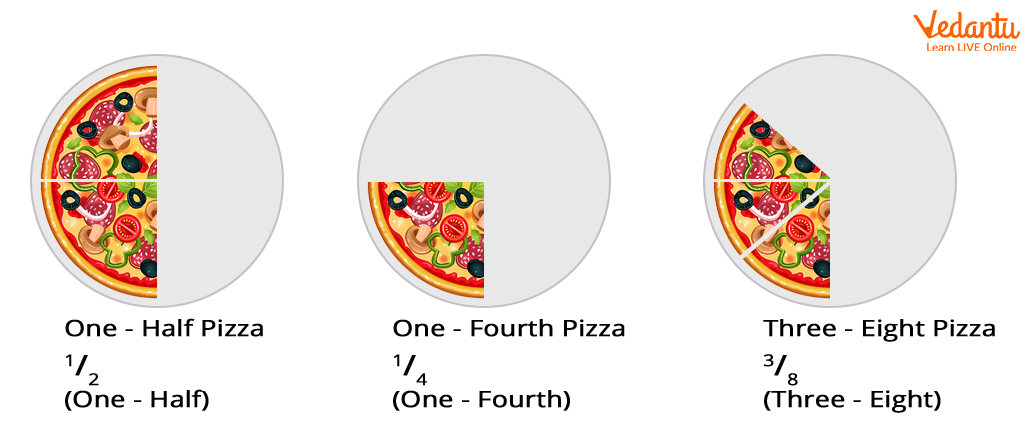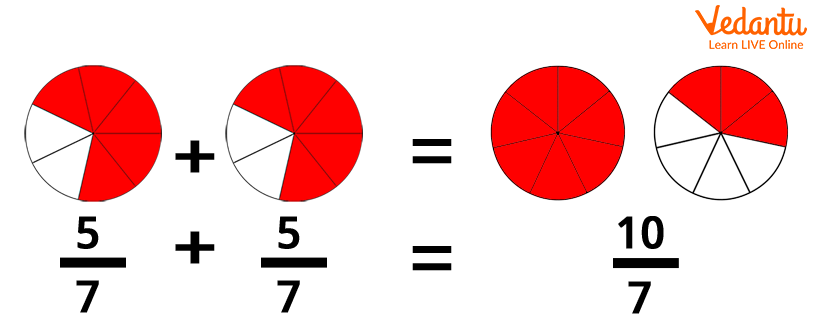




Solved Examples: Multiplying Fractions by Whole Numbers
Do you want to know what fractions and whole numbers are?
And!
How do fractions get multiplied by a whole number?
Here, we will discuss the two mathematical terms ‘Fractions’ and ‘Whole Number’ and how to multiply a fraction by a whole number in an easy way.
What Is a Fraction?
A fraction is nothing but a numerical value that represents a part of a whole unit.
Let us understand fractions with an example in a better way.
Slice a pizza, and you get a fraction.
Multiply Fraction by a Whole Number in Just 2 Steps
Do you want to know what fractions and whole numbers are?
And!
How do fractions get multiplied by a whole number?
Here, we will discuss the two mathematical terms ‘Fractions’ and ‘Whole Number’ and how to multiply a fraction by a whole number in an easy way.
What Is a Fraction?
A fraction is nothing but a numerical value that represents a part of a whole unit.
Let us understand fractions with an example in a better way.
Slice a pizza, and you get a fraction.

Here,
The top number says how many slices you have.
The bottom number says how many equal sizes the whole pizza was split into.
Parts of A Fraction
A fraction has two parts, namely the numerator and the denominator.
The number written above the line is termed as the numerator. The numerator is the number of parts we have.
The number written below the line is termed as the denominator. The denominator is the number of parts the whole unit is split into.
The line that separates both the numerator and denominator is called a ‘Fraction Bar’ or ‘Vinculum’.
\[ \frac{Numerator}{Denominator} \]
Types of Fraction
Proper Fraction: A fraction whose numerator value is less than the denominator value is termed as proper fraction. For example, \[ \frac{2}{7} \], \[ \frac{3}{10} \],\[ \frac{1}{2} \], etc. are proper fractions.
Improper Fraction: A fraction whose numerator value is equal to or more than the denominator value is termed as improper fraction. For example, 5/2, 8/5, etc. are improper fractions.
Mixed Fraction: A fraction that is a combination of whole and a part is termed as a mixed fraction. For example,\[ 3\tfrac{1}{4} \] , \[ 2\tfrac{1}{2} \], etc. are mixed fractions.
What Are Whole Numbers?
In mathematics, whole numbers are simply numbers starting from 0. For example:
0, 1, 2, 3, 4, 5, 6, 7, 8, 9,.... and so on
Remember!
Whole numbers do not include negative numbers, fractions and decimals.
Instead, whole numbers include only positive counting numbers.

How to Multiply a Fraction by a Whole Number in Two Steps?
The two steps to multiply a fraction by a whole number are as follows:
Step 1: Multiply the numerator values.
Step 2: Leave the denominator of the fraction the same.
Example:
Multiply \[ \frac{3}{2} \] x 5
Step 1: Multiplying the numerator values gives:
3 x 5 = 15
Step 2: Leaving the denominator of the fraction the same. Accordingly, the denominator will be 2.
Now:
The new numerator is 15.
The denominator 2 remains the same.
Hence,\[ \frac{3}{2} \] x 5 = \[ \frac{15}{2} \]
How to Multiply a Fraction by a Whole Number in Four Steps?
Step 1: Convert the whole number into a fraction with a denominator of 1. (We are doing this because anything divided by 1 remains the same).
Step 2: Multiply the numerators.
Step 3: Multiply the denominators.
Step 4: Simplify the fraction, if required.
Let us understand with an example:
Multiply \[ \frac{3}{2} \] by 8
Step 1: Convert the whole number into a fraction with a denominator of 1.
8 = \[ \frac{8}{1} \]
Step 2: Multiply the numerators.
3 8 = 24
Step 3: Multiply the denominators.
2 x 1 = 2
Hence,
The new fraction is \[ \frac{24}{2} \]
Step 4: Simplify the fraction:
\[ \frac{24}{2} \] = 12 or \[ \frac{12}{1} \]
How to Multiply a Mixed Fraction by a Whole Number?
The following are the steps to multiply a mixed fraction by a whole number:
Step 1: Convert the mixed fraction into an improper fraction.
Step a: Multiply the whole number by the improper fraction.
Note: To convert a mixed fraction into an improper fraction, multiply the whole number by the denominator and then add the result or product obtained by the numerator to get the new numerator value of the improper fraction. The denominator value of the improper fraction will be the same as it was before.
Example:
Multiply 3 x \[ 2\tfrac{5}{7} \]
Solution:
Step 1: Converting the mixed fraction into the improper fraction.
\[ 2\tfrac{5}{7} \]= \[ \frac{2 \times 7+5}{7} \]= \[ \frac{19}{7} \]
Step 2: Multiplying the improper fraction obtained in step 1 by the whole number.
\[ 3\frac{19}{7} \] = \[ \frac{19 \times 3}{7} \] = \[ \frac{57}{7} \]
Therefore, \[ 3 \times 2\tfrac{5}{7} \] = \[ \frac{57}{7} \] or \[ 8\tfrac{1}{7} \]
How Does Multiplying a Fraction by a Whole Number Work?
When a fraction gets multiplied by a whole number, it works as a repeated addition.
Let’s understand with an example:
Multiplying \[ \frac{5}{7} \] by 2 is the same as \[ \frac{5}{7} \] + \[ \frac{5}{7} \]

Remember! \[ \frac{5}{7} \] x2 = \[ \frac{5}{7} \] x \[ \frac{2}{1} \]= \[ \frac{5x2}{7x1} \] = \[ \frac{10}{7} \]
Hence, proved
Multiplication of Whole Number by Fraction Example Problem
Let’s say there are 10 oranges in the basket and \[ \frac{3}{5} \] of them are sour. How many oranges are sour?
Solution:
Finding \[ \frac{3}{5} \] by 10 is similar to \[ \frac{3}{5} \] x 10
Now, follow the above steps to multiply.
\[ \frac{3}{5} \] \times 10 = \[ \frac{3}{5} \] x \[ \frac{10}{1} \] = \[ \frac{3 \times 10}{5 \times 1} \] = \[ \frac{30}{5} \] = 6
Hence, 6 of the oranges are sour.
Did Any of You Know?
The addition and multiplication of any two whole numbers can be done in any order.
All numbers except 0 have an immediate predecessor or number that comes before.
The decimal expansion of fraction either ends or keeps on repeating. For example, \[ \frac{1}{4} \] = 0.25, \[ \frac{1}{7} \] = 0.142857142857. On the other hand, the decimal expansion of irrational numbers nevers repeats.
Conclusion
In short, multiplying mixed numbers with whole numbers is a simple four step process. To convert, you just need to write the whole number as a fraction with a denominator equal to 1. Multiply both numerator and denominator values. Simplify the result if possible.
FAQs on How to Multiply a Fraction with a Whole Number: Step-by-Step Guide
1. What are the steps to multiply a fraction by a whole number?
To multiply a fraction by a whole number, follow these three simple steps:
- Step 1: Write the whole number as a fraction by placing a 1 in its denominator. For example, the whole number 5 becomes the fraction 5/1.
- Step 2: Multiply the numerators (the top numbers) of the two fractions.
- Step 3: Multiply the denominators (the bottom numbers) of the two fractions.
- Step 4: Simplify the resulting fraction if needed. For example, to solve 4 x (2/5), you calculate (4/1) x (2/5) = (4x2)/(1x5) = 8/5.
2. How do you multiply a whole number with a mixed fraction?
When multiplying a whole number by a mixed fraction, you must first convert the mixed fraction into an improper fraction. For instance, to multiply 3 by 2 1/4, you would:
- Convert 2 1/4 to an improper fraction: (4 * 2 + 1) / 4 = 9/4.
- Now, multiply the whole number by this new fraction: 3 x (9/4).
- Treat the whole number as a fraction (3/1) and multiply: (3/1) x (9/4) = 27/4.
- Finally, you can convert the result back to a mixed fraction if required, which would be 6 3/4.
3. What is the very first step when multiplying a whole number by any type of fraction?
The most important first step is to represent the whole number as a fraction. You can do this by simply placing the whole number over a denominator of 1. For example, if you need to calculate 7 multiplied by 2/3, your first action is to think of 7 as 7/1. This makes the problem a standard fraction-by-fraction multiplication.
4. Why do we only multiply the whole number with the numerator and not the denominator?
This is a key concept. The denominator of a fraction tells you the size of the 'pieces' (e.g., 'fifths' or 'eighths'), while the numerator tells you how many of those pieces you have. When you multiply by a whole number, like 3 x (2/5), you are essentially saying you want '3 groups of two-fifths'. You are increasing the number of pieces (2 pieces * 3 = 6 pieces), not changing their fundamental size. Therefore, you are left with 6/5, and the denominator remains the same during this step.
5. Can you explain the multiplication of a whole number and a fraction using a real-world example?
Certainly. Imagine you are baking and a recipe calls for 3/4 of a cup of sugar. If you want to make 5 batches of the recipe, you need to calculate 5 x (3/4). This means you need 5 groups of 'three-quarters' of a cup. By multiplying the whole number (5) and the numerator (3), you get 15. The result is 15/4 cups. This improper fraction can be simplified to 3 3/4 cups of sugar in total. You are multiplying the quantity of sugar, not the size of the cup.
6. What is the difference between multiplying a fraction by a whole number and adding a fraction to itself that many times?
There is no difference in the final answer; they are two ways to understand the same operation. Multiplication is essentially a shortcut for repeated addition. For example:
- Multiplication: 4 x (1/5) = 4/5.
- Repeated Addition: 1/5 + 1/5 + 1/5 + 1/5 = 4/5.
Both methods demonstrate that you have four 'one-fifth' parts, which gives you a total of four-fifths. Using multiplication is simply more efficient, especially with larger whole numbers.
7. When is it necessary to convert an improper fraction back into a mixed number after multiplying?
While an improper fraction like 11/4 is a mathematically correct answer, converting it to a mixed number (2 3/4) is often necessary for practical understanding and application. As per the CBSE/NCERT syllabus for the 2025-26 session, simplifying answers to their most readable form is a good practice. In word problems, a mixed number makes the final answer, like '2 and 3/4 metres', much easier to interpret than '11/4 metres'.
8. If you multiply a whole number greater than 1 by a proper fraction, will the answer be bigger or smaller than the original whole number?
The answer will always be smaller than the original whole number. This is because a proper fraction (like 1/2 or 3/4) always represents a value less than one. When you multiply a number by a value less than one, you are essentially finding a 'part' of that number, which results in a smaller value. For example, 5 x (1/2) = 2.5, and 2.5 is smaller than 5.

















